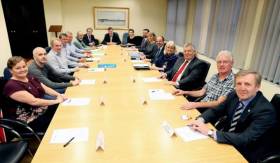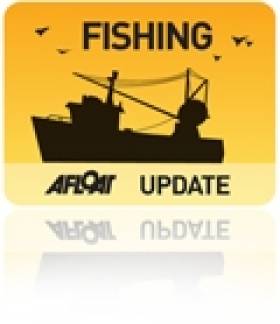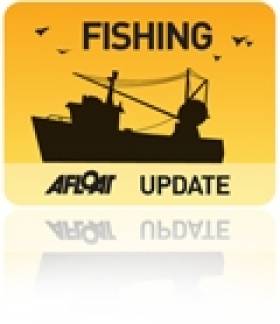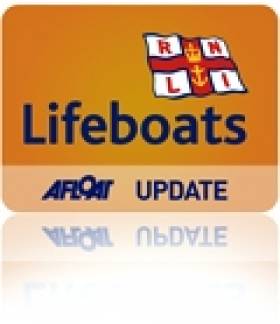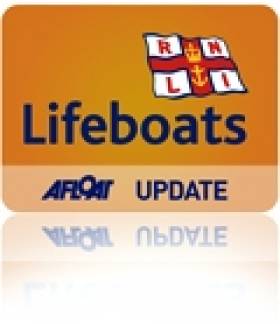Displaying items by tag: Inshore
New Website For National Inshore Fisheries Forums
#Fishing - A new website for the National Inshore Fisheries Forums (NIFF) was launched by Marine Minister Michael Creed yesterday (Tuesday 25 October).
“Getting inshore fishing communities involved in decision-making is the key aim of the forum initiative,” said the minister, who added that the website “is a vital tool both to make information available and also to foster interaction and discussion.
“I hope that it will become a regular port of call for all interested in developing a sustainable future for this sector.”
Minister Creed also thanked Bord Iascaigh Mhara and the forum delegates for their contributions to the website at www.inshoreforums.ie, launched at the eighth meeting of the NIFF since it was established in 2014.
Budget 2017’s introduction of the Fisher’s Tax Credit (based on the seafarer’s allowance model) and changes to the Fish Assist Scheme were highlighted as important income support mechanisms for inshore fishing communities.
The inshore sector — comprising fishing boats of less than 12 metres in overall length — makes up more than 80% of the fishing fleet, and is predominately active within six nautical miles of the Irish shore.
Minister Creed acknowledged the role of the NIFF and others in the fishing industry in advocating for income support.
“Maintaining jobs and attracting new entrants have been identified by our stakeholders as a key challenge for our fishing industry, including the inshore sector,” he said.
“This annual tax credit specifically for fishermen of €1,270, which mirrors the value of the Seafarer’s allowance, is important recognition for their contribution to Ireland’s Blue Economy.”
Yesterday’s NIFF meeting also tabled proposals to revise the conservation measures for lobster, and to introduce technical conservation measures for the velvet crab fishery.
Creed Hosts Year's First Inshore Fisheries Forum
#Fishing - New Minister for Agriculture, Food and the Marine Michael Creed hosted his first meeting of the National Inshore Fisheries Forum (NIFF) yesterday, Wednesday 22 June.
The minister met with the chairs and vice-chairs representing the six Regional Inshore Fisheries Forums (RIFFs) to hear their proposals for the future development of the inshore fisheries sector.
The inshore sector – comprising fishing boats of less than 12m in overall length – make up more than 80% of the fishing fleet and are predominately active within six nautical miles of the Irish shore.
“I am pleased that there was a focus in today’s discussions on priorities to ensure a positive longterm future for this sector," said Minister Creed. "This Government has committed to the development of the inshore sector. To deliver this, it is essential to hear the views of the stakeholders themselves through the NIFF.
"With EMFF funding now available, there are opportunities to secure sustainable inshore fisheries and enhance incomes in rural, coastal communities.” Among the range of issues discussed at yesterday’s meeting were access to herring stocks, and proposals to develop national conservation measures for velvet crab.
This was the seventh meeting of the NIFF (not to be confused with the National Inland Fisheries Forum), which was established in 2014 to facilitate the development of a coherent inshore sector 'voice' by encouraging inshore fishermen to discuss their fishing issues and generate commonly-supported initiatives.
A network of six Regional Inshore Fisheries Forums (RIFFs) around the Irish coast have nominated delegates to bring forward regional proposals to the NIFF for wider industry discussion.
These RIFF members include inshore fishermen, environmental interests, marine leisure, marine tourism and other marine stakeholders.
The structures also provide opportunities for collaboration between the inshore fishing sector and their communities on sustainable strategies to optimise the income opportunities afforded by the coastal resource.
First Ever National Inshore Fisheries Forum Held
#fishermen – The Minister for the Marine, Simon Coveney T.D. today hosted the first meeting of the National Inshore Fisheries Forum (NIFF), bringing together for the first time a network of representatives from the six recently established Regional Inshore Fisheries Forums. The inshore sector (comprising fishing boats of less than 12 metres in overall length) make up more than 80% of the fishing fleet and are predominately active within six nautical miles of the Irish shore.
Speaking ahead of the first NIFF meeting the Minister said: "In May last year I announced a package of measures to support the sustainability and viability of the inshore fisheries sector. I have long been concerned that Ireland's inshore fishermen have been poorly represented in national policy making structures and to address that deficit, and as part of the package of measures, I took the innovative step of setting up of the forum initiative. I am delighted that inshore fishermen are buying into this opportunity to focus the priorities on what is needed to ensure the long term future in their sector. I look forward to appointing the first Chair and Vice-Chair at today's meeting."
The NIFF has been set up to facilitate the development of a coherent inshore sector "voice" by encouraging inshore fishermen to discuss their fishing issues and generate commonly-supported initiatives. A network of Regional Inshore Fisheries Forums (RIFFs), based on and linked to the community-led Fisheries Local Action Groups (FLAGs) around the Irish coast, have nominated delegates to bring forward regional proposals to the NIFF for wider industry discussion. The RIFF members include inshore fishermen, environmental interests, marine leisure, marine tourism and other marine stakeholders. The structures also provide a new opportunity for collaboration between the inshore fishing sector and their communities on sustainable strategies to optimise the income opportunities afforded by the coastal resource.
Michael Keatinge, BIM's Interim CEO and Fisheries Development Director stressed the value of the NIFF to the sector; 'This is a unique opportunity to develop our valuable inshore fishery not just in terms of short term improvements but to ensure the long term sustainability of our stocks which in turn will protect revenue and employment in our fishing reliant coastal communities. Today's meeting is a positive step forward in this regard and the issues discussed including conservation, enforcement and the collation of landings data will enable this industry to be best placed to secure a viable future. I am pleased to say that our industry's commitment to conservation is clear with a phenomenal response to the BIM Lobster V-notching Scheme last year with over 33,000 lobsters v-notched compensating fishermen to the tune of more than €250,000 and we are expecting an even greater response this year. BIM are looking forward to assisting the Minister, the Department and industry to ensure this initiative plays a key role in the development of our inshore fishing sector'
Challenges facing the inshore sector including the reformed CFP and protecting Natura 2000 sites as well as feedback from the recent consultation on a proposed management plan for razor clam fishing in the North Irish Sea were discussed at today's meeting. Other important fisheries for the inshore sector for discussion included lobster, crab and opportunities for diversification to maintain a viable inshore sector.
BIM Seeks Members for Regional Inshore Fisheries Forums
#inshorefisheries – Following the launch of the National Inshore Fisheries Forum (NIFF) earlier this year by the Minister for Agriculture, Food and Marine, Mr. Simon Coveney T.D. and the recent agreement on the terms of reference for the forum; BIM are now seeking members to take part in the Regional Inshore Fisheries Forums (RIFFs). Each RIFF will feed into the National Inshore Fisheries Forum and will link with the existing infrastructure of the Fisheries Local Action Groups or FLAG's programme. There are six FLAG's established in coastal regions around Ireland.
The RIFFs will comprise of no more than 12 members.
A minimum of 8 members will represent the inshore fisheries sector and will be appointed on the basis of:
their ability to represent the views of the inshore sector
their knowledge of inshore fisheries, fish stocks, and fishing methods, and
their capacity to engage on fisheries management issues.
In addition, the FLAG will aim to ensure that the membership is representative of the FLAG region's geographical coverage and the characteristics of the region's inshore fleet and fisheries. Applicants must demonstrate support within their respective sector for their nomination to a forum. The balance of the membership will include stakeholders from marine sectors other than fisheries, such as seafood processing/sales, marine leisure, marine tourism, environmental NGOs and community organisations.
Should the FLAGs consider a sector or area is lacking in representation the FLAG reserves the right to approach appropriate individuals or organisations to seek members.
If you are interested in applying for membership of the RIFFs, please e-mail Caroline Curraoin in BIM [email protected] or send your application by post to FLAG Co-ordinator, BIM, , P.O. Box 12, Crofton Rd., Dun Laoghaire , Co. Dublin. Full details on the terms of reference for the National Inshore Fisheries Forum are available on www.bim.ie
The closing date for all applications is Friday, 29th August 2014.
#Fishing - Marine Minister Simon Coveney has announced a package of measures to develop the inshore fisheries sector.
The package is targeted at the inshore fishing sector and consists of three parts including the establishment of a National Inshore Fisheries Forum, supported by a network of Regional Inshore Forums in each of the Fisheries Local Action Group (FLAG) regions.
There will also be a funding programme worth up to €1m for the inshore sector, and conservation measures to support lobster and shrimp stocks.
The inshore sector (fishing boats of less than 12m overall length) comprises over 80% of the fishing fleet and is predominately active within 6 nautical miles of the shore.
Announcing the establishment of the National Inshore Fisheries Forum (NIFF), the minister said: “Ireland’s inshore fishermen are poorly represented by current structures and need a dedicated platform where they can discuss and develop common initiatives.
"I hope that inshore fishermen will embrace this opportunity created by the new structures to have a coherent voice which can be heard clearly.”
The NIFF is being set up to encourage inshore fishermen using small fishing boats to participate in the management of their fisheries.
A network of Regional Inshore Forums (RIFs), based on and linked to the community-led FLAGs around the Irish coast, will nominate delegates to bring forward regional proposals to the NIFF for wider industry discussion. The structures will also provide a new opportunity for future consultation with the inshore fishing sector.
Meanwhile, Minister Coveney committed to a total funding programme for inshore fishermen in 2014 worth up to €1m. This is aimed at providing financial assistance for sustainable, environmentally friendly fishing practices and the recent safety equipment and training initiative.
Support will be available under the new Sustainable Inshore Fisheries Scheme for a range of measures including:
- An enhanced v-notching programme with increased coverage around the coast (grant aid increased from current maximum 55% to 75%);
- Gear and equipment to support responsible fishing practices (such as mackerel jigging, potting for crayfish); abd
- Improvements in the area of quality, hygiene, and standards on board.
A supplementary Shellfish Pot Replacement Scheme will also be launched to provide extended assistance to fishermen who lost pots during the exceptional winter storms, more than doubling the pot limits from 50 to 200 for boats less than 12m length and from 100 to 250 for boats from 12 to 15m in length.
Existing applicants to the current scheme will automatically be increased to the supplementary pot limits and a call for new applications will be advertised.
Following on extensive consultation in 2013, the minister also approved plans to revise conservation measures for lobster and shrimp.
Given the importance of very large lobsters to the reproductive potential of the stock, a maximum landing size for lobster of 127mm will be introduced by legislation in the coming months.
During the first two years of operation of this new measure, fishermen will be paid up to 75% of the market price for v-notching ‘oversize’ lobsters and returning them live to sea. In addition the grant aid for voluntary V notching of Lobsters is being increased from the existing maximum of 55% to a new maximum of 75%.
In addition, a revised closing date for the shrimp fishery of 15 March instead of 1 May will commence from 2015 to provide stock protection during the spawning period.
Minister Coveney said: “I am asking the Regional Inshore Forums, as a first initiative, to identify lobster stock enhancement areas within their regions where hatchery-grown juveniles could be released. Lobsters are one of the most important species to the inshore sector and we need to dedicate resources to ensure the long-term future of this valuable stock.
"I have also asked BIM to work with the Marine Institute to develop a pilot project for a national lobster hatchery as an additional conservation tool.”
'Eagle-Eyed' Angler Fishes Wedding Ring from the Lee
#ANGLING - An "eagle-eyed" angler in Co Cork received a free eye test after his remarkable find of a wedding ring in the water last week.
Seventy-five-year-old Pat O'Flaherty spotted the €400 gold band - complete with its red box - in the River Lee, garnering him a front-page story in the Irish Examiner and a free eye test from Specsavers.
They put me in the chair and did all the tests and told me I have 20:20 vision," he said.
The owner of the ring has yet to be traced, despite much speculation as to how it ended up in the Lee in the first place. If unclaimed, O'Flaherty intends to auction the ring for charity.
In other angling news, West Cork's Courtmacsherry Angling Centre hosted members of the Bradford Sea Angling Club in the UK last weekend.
Poor weather meant that the group was restricted to inshore fishing on the Friday and Saturday, but the Sunday saw a catch of ling up to 23lbs as well as pollack, coalfish, cod, haddock and whiting.
Humpback Whale Spotted Off Achill
#MARINE WILDLIFE - The Irish Whale and Dolphin Group has confirmed the sighting of a humpback whale off Achill Island in Co Mayo last weekend.
Surfers off Keel Beach were credited with the discovery, after spotting a large whale of 30-60ft breaking the surface multiple times, lifting its tail fluke vertically.
The sighting is only the fifth validated record of a humpback whale off the coastal area from Galway to Donegal.
"It remains something of a mystery as to why sightings of this species remain such relatively rare events along our west and northwest compared to our south and southwest coasts," says IWDG sightings co-ordinator Pádraig Whooley.
"This latest sighting is a timely reminder that species such as humpbacks can and do turn up in places that are well outside what we perceive to be the known 'hotspots'."
Humpback whales tend to feed in inshore waters, which should make them increasingly easier for the public to spot from the shore, he added.
The IWDG has more on the story HERE.
Dramatic Photos of Clifden Lifeboat Battling Surf
John organised the training in response to the increased popularity of the area with surfers. RNLI Divisional Assessor Trainer Helena Duggan travelled to the lifeboat station to put 18 volunteer lifeboat crew through their paces and train them in handling the lifeboat in surf and responding to potential callouts from leisure marine enthusiasts.
Training is a core part of volunteering with the RNLI and each crewmember in Clifden trains once a fortnight on the stations two inshore lifeboats.
Commenting on the exercise John said, "I took my camera down to photograph the exercise and was really pleased with the results. It is great to be able to show the public what our lifeboat volunteers go through to ensure they are fit and trained to go to sea. We had a fantastic turnout on the day and the lifeboat crew learned about boat handling in surf conditions. We are delighted so many people are visiting the area for leisure marine activities."
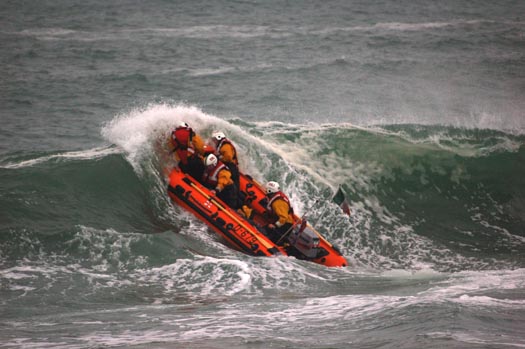

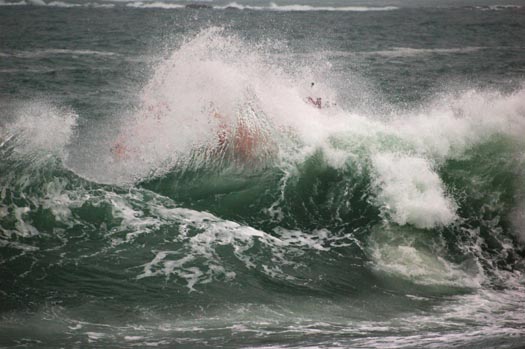
Photos by John Brittain/Clifden RNLI show Clifden volunteer lifeboat crew with RNLI Training assessor Helena Duggan during surf training on Dunloughan beach, Ballyconeely
Related Safety posts
RNLI Lifeboats in Ireland
Safety News
Rescue News from RNLI Lifeboats in Ireland
Coast Guard News from Ireland
Water Safety News from Ireland
Marine Casualty Investigation Board News
Marine Warnings
Proposed Irish Sea Conservation Zones
The area include the inshore waters of Merseyside, Lancashire and Cumbria and offshore waters of the Isle of Man, Wales, Northern Ireland and England. One of the zones is a 187 square km stretch of deep water between Northern Ireland and the Isle of Man.
In order to gain a greater understanding of the proposed zones, the report commissioned a Regional Stakeholder Group which drew from a diverse range of interests in the Irish Sea. Among the stakeholders included were the Royal Yachting Association, the fishing community and ports authorities. The review identified the size, shape and locations of the proposed 10 ten new Marine Conservation Zones. For the first time, the zones included inshore water of the Irish Sea project area as well as offshore.
"This is a real milestone for the project, with potential Marine Conservation Zones identified in both inshore and offshore waters", said Greg Whitfield, project manager at Irish Sea Conservation Zones.
"It is now really important that people take a look at the potential zones and give us their feedback on them. The better the information we have, the better the Marine Conservation Zones that are recommended by the regional stakeholder group will be."
Each of the marine conservation zones are designed to protect nationally important marine wildlife, habitats and geology. In addition they are designed to have the least impact possible on people's activities, but some restrictions will apply as the zones must meet guidelines for protecting species and habitats.
Members of the public are being invited to participate and will be considered as the second project continues to refine its proposals. The report is only a snapshot of the work so far. It does not contain concrete recommendations for the locations of Marine Conservation Zones (MCZ) in the Irish Sea, and the potential zones shown in the report are described as tentative and liable to change.
The Irish Sea Conservation Zone project will be releasing a third report before the Regional Stakeholder Group finalises its recommendations. The reports are delivered to the Science Advisory Panel. The independent body is comprised of expert scientists whose main role is to evaluate the potential of MCZs against ecological criteria.
The third progress report will be made available in February 2011. Its final recommendations will then be presented to the UK government in June. Following that a formal public consultation on the proposed MCZs are to take place in late 2011 and early 2012.
For information on the Second Progress Report including feedback forms can be downloaded from HERE or by calling 00 44 (0)1925 813 200
Family Say 'Thank You' to Portrush Lifeboat for Saving Son
A grateful family presented a cheque to Portrush lifeboat crew in thanks for saving their son this summer.
On 16th May 2010 both Portrush Lifeboats were launched to two separate incidents within one at 0922 hours and one at 0924 hours.
Within minutes two full volunteer crews had assembled and both the All-weather Lifeboat and the Inshore Lifeboat were launched. The Inshore Lifeboat was launched to reports of two young people in the water at Dhu Varren. Karl O'Neill was at the helm supported by Nick Christie and Jonathan Weston. Two youths had gone into the sea after a dog, and were starting to experience real difficulties in getting back to shore. One of the youths Damian Morris had sustained cuts to his arms and legs, was suffering hypothermia and was literally going under the water for the third time when the Portrush Lifeboat arrived on scene. Damian spent several days in hospital as a result of the incident and was delighted to be able to come to the station to meet the crew who had saved him that day.
Damian's uncle and Godfather Raymond Comac and his friend Paul McGuigan, do a lot of charity work in Damian's hometown in Omagh holding fundraisers to raise funds to take motorbikes out to South Africa for use by health care workers in the townships. However this year, they divided the proceeds between their charity and the RNLI, in recognition of the fact that the volunteer crew at Portrush had saved Damian's life.
Damian's parents Liam and Rosemary Morris, Damian himself and his uncle Raymond and friend Paul travelled to Portrush to meet the crew and hand over a cheque for £1000. Both Nick and Karl were overwhelmed by the generosity and stated;
'We don't do this for thanks, but it's so nice to meet someone that you have helped and for this amount to be raised is fantastic for the station'
The family got a tour of the station and had a look at the new Inshore lifeboat 'The David Roulston' which took over from the 'Ken and Mary' the boat that responded to the call that day....one of her last launches.

Related Safety posts
RNLI Lifeboats in Ireland
Safety News
Rescue News from RNLI Lifeboats in Ireland
Coast Guard News from Ireland
Water Safety News from Ireland
Marine Casualty Investigation Board News
Marine Warnings


























